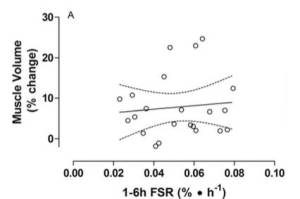
Protein synthesis and muscle hypertrophy: No more proxies

Taken from: http://nomoremutants.com/
Frankly, I’m surprised this study didn’t make more of a splash. I think this is a huge finding, even if it does require further work (but really, what study doesn’t end in, “More research is required…”? I can’t even imagine what would happen if someone wrote, “No further research is required.” Probably a rain of frogs, I suspect.)
The concept of a proxy measurement is one that I’ve discussed before. In a nutshell, it is an indirect measurement of something that cannot be, or is difficult to measure directly. It is difficult to accurately measure how much fat is in someone’s body. A true direct measurement would involve dissecting out all of the fat in person and weighing it. A near-direct measurement would be a whole body MRI whereby fat could be quantified. After that, we start getting into indirect measurements: DEXA, underwater weighing, skin calipers, bioimpedance; these are all proxy measurements for body fat. We use these measurements because after dissecting all the fat off a person, they would probably get really really cold.
Mitchell CJ, Churchward-Venne, TA, Parise G et al. Acute post-exercise myofibrillar protein synethesis is not correlated with resistance training-induced muscle hypertrophy in young men. PLOS One, 9(2): e89431, 2014.
Myofibrillar protein synthesis is, simplistically, the rate at which protein is being made in muscle tissue. Its baseline rate is measured by infusing a labelled form of phenylalanine for a set period of time, and then taking a muscle biopsy some time later and seeing how much of the labelled form of phenylalanine is in the muscle biopsy. You can then figure out how much protein synthesis goes up or down when you take another muscle biopsy to see how much of the labelled phenylalaine is in it (provided a bunch of experimental conditions are also met, but I’m going to go through those here.)
Protein synthetic rate has been used as a proxy for hypertrophy for decades. Almost all of the protein supplement studies have used MPS (myofibrillar protein synthesis) or FSR (fractional synthetic rate) as evidence to show that protein works. After all, if the MPS goes up after exercise and a protein drink, that means the muscle MUST be getting bigger, right?
I’ve written before about the problem of using MPS as a proxy for muscle hypertrophy; namely, it only measures on aspect of the hypertrophy process—synthesis. What isn’t measured is the catabolic aspect of muscle injury as it pertains to the theory of muscle hypertrophy: The stimulus for tissue growth is tissue injury. Additionally, MPS is usually measured by taking a muscle biopsy; and you can’t (well, not easily anyways) take too many repeated biopsies over time without eventually doing some actual tissue damage, so while you might have an idea of what happens acutely after an intervention, it’s not always possible to reasonably extrapolate past the collected data. However, MPS remains the mainstay measurement for testing everything from hypertrophy exercise protocols, supplement effectiveness, as well as just general protein synthesis (which is ACTUALLY what MPS is supposed to be used for)
What makes this study special is that it attempts to validate MPS with what we’re actually interested in: “Does the well-recongized observed increase in MPS after exercise and protein supplementation have a relationship with muscles getting bigger?” which is a question that has NOT been answered in any literature to date (though there is a previous study which looked at MPS and hypertrophy in the fasted state)
Methods
The researchers recruited 23 males who were, “recreationally active, but had not engaged in resistance training within the last year.”
[I think it’s important to highlight that taking so-called ‘untrained’ subjects is not always a problem; and it certainly is not one here. If anyone is going to experience hypertrophy, it’s the lifting beginner. Experienced lifters who have already gone through their initial hypertrophy gains have to fight for every little bit of extra tissue, which would have massive adverse effects on the sample size required in this study. If a relationship between MPS and hypertrophy is to be found, it’s going to be in people who can show substantial hypertrophy because they’re relatively far away from their genetic/environmental ceiling.]
The participants all had MRI’s of their right thighs to determine muscle volume. They were instructed not to perform any strenuous activity 24h before their scans, and were rested lying down for 1 hour before the scan to prevent fluid shifts from affecting the scan. They also had baseline DEXA scans, and strength testing for 1RMs for the lifts in their program.
At least 5 days after strength testing, participants went through a 10h overnight fast during which they had their stable isotope infusions. Resting MPS was measured, and then they trained (leg press, leg extension, leg curl, calf press.) They were then given 30g of protein, 25g of carb 3.4g of fat in a shake. Muscle biopsies were then taken at 1, 3 and 6 hours after exercise to measure MPS at those time points.
The participants then went through a 16-week strength training program, which included a post-workout drink (same composition) right after the workout; and with breakfast on rest days. The program involved 2 upper body days, and 2 lower body days with linear progression. After 16 weeks, they went through the scans and strength testing again.
The investigators then compared the MPS rate (which is the difference in MPS at baseline to 6 hours over time) to percent change in thigh muscle volume amonst other things (I am only focussing in on the main outcome in this post.)
Results
It is useful to look at some of the other variables, because they pre-empt some of the questions regarding some of the potential limitations of this study:
1) Did the training program work?
From a strength point of view, almost all of the subjects got stronger over 16 weeks. Changes in bone-free fat-free mass were modest, which is to be expected over just 16 weeks; but where the money is lies in the change in quadriceps volume when measured by MRI. One of the strongest reporting points of this paper is the graphing of individual data points, with superimposed summary statistics. Most subjects (66%) gained between 20-ish to 250cm^2 of volume in their quads over 16 weeks. Two subjects had no change in quadricep volume.
2) Was there an increase in MPS?
The short answer is yes. From the resting MPS, there was an approximate 2-fold increase in MPS in the post-exercise period up to 6 hours. Measurements past 6 hours were not taken. I was a little disappointed that this was graphed in a similar way—there was no way to tell whether individuals were following the mean increase trend, or if it was an aggregate effect that was observed.
 However, where this study pulls it together is when they looked at the total percentage rate of MPS (which is basically a representation of the total accrued protein) over 6 hours and the change in muscle volume. You would expect subjects who had the highest change in muscle volume to have the highest total MPS rate. But that clearly does not pan out.
However, where this study pulls it together is when they looked at the total percentage rate of MPS (which is basically a representation of the total accrued protein) over 6 hours and the change in muscle volume. You would expect subjects who had the highest change in muscle volume to have the highest total MPS rate. But that clearly does not pan out.
So what does this mean?
I think this is a huge blow to a lot of protein synthesis research as it pertains to hypertrophy. It means that single-point testing is probably not predictive of hypertrophy. It calls into question almost all of the evidence looking at nutrient supplementation and hypertrophy short of the trials that actually measured hypertrophy (which is most of them, because there are not that many ultrasound or MRI studies on hypertrophy). It also means that strategies to promote MPS (eating frequent doses of protein over the course of the day, for instance) may actually be ancillary, and not core, must-do behaviours.
Suffice it say, I think this derails a lot of existing research and opens an exciting path to a proxy-free research approach that will hopefully glean us better and more accurate answers.